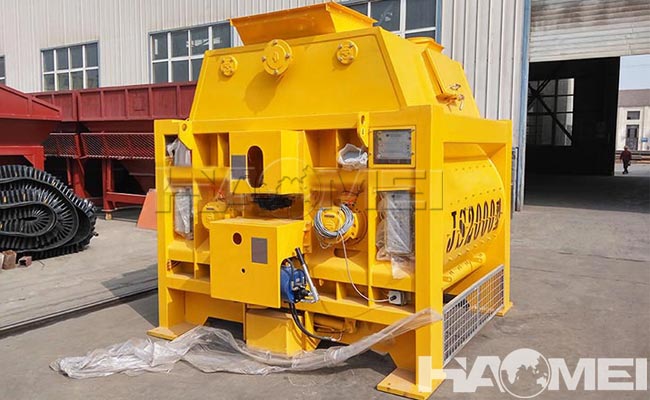Categories
- Case & News (50)
- Blog (561)
The working principle of twin shaft compulsory concrete mixer is based on its unique mixing method. It mainly consists of two horizontally connected horizontal groove-shaped mixing drums, two mixing shafts rotating in opposite directions and a rotating mechanism. Several sets of mixing blades are installed on these two shafts, which are staggered in a certain space at the front and back of the top and bottom, so that the mixture is stirred in turn in the two mixing cylinders. During the mixing process, on the one hand, the mixing material at the bottom and the middle of the mixing cylinder is turned upward, and on the other hand, the mixing material is pushed forward and backward along the axes, so that the mixing material can be stirred quickly and evenly.

The overall structure of twin shaft compulsory concrete mixer is mainly composed of the following parts:
– Mixing device: it mainly includes mixing cylinder, mixing shaft and mixing shovel. The mixing shovel is installed on the mixing arm and works with the rotation of the mixing shaft.
– Transmission system: it is composed of gear motor and coupling, etc., which is responsible for driving the rotation of mixing shaft.
– Frame: usually made of welded channel steel, which is an important supporting part of the mixing equipment.
– Limit device: mainly includes locking pins and positioning holes, used to ensure that the mixing device stops at a specific position.
– Electrical control system: the main functions include starting, spotting, stopping and timing to control the operation of the mixer.
There are various models of twin shaft compulsory concrete mixer, and the common models include JS500, JS750, JS1000, JS1500, JS2000, JS3000 and so on. Different models of twin shaft concrete mixers have different feeding capacity and discharging capacity, which determines the amount of concrete they produce each time. For example:
JS500 concrete mixer has a feeding capacity of 800L and a discharging capacity of 500L, which can produce 0.5 cubic meters of concrete per production.
JS1000 concrete mixer has a feeding capacity of 1600L and a discharging capacity of 1000L, which can produce 1 cubic meter of concrete per production, so it is also known as a party mixer.
JS3000 concrete mixer has a feeding capacity of 4800L and a discharging capacity of 3000L, which is a kind of large concrete mixer equipment.
Advantages of twin shaft compulsory concrete mixer:
– Uniform mixing: Due to the structure of double shaft or double horizontal shaft, the mixing energy of the blades is released more completely, and the movement of the materials is also more adequate, so the mixing effect is more uniform and more efficient.
– Convenient discharging: the discharging door is installed at the bottom of the concrete mixer, and the start of discharging is realized through the cylinder, which is easy to operate. At the same time, the design of the discharge door is conducive to reducing concrete leakage.
– Long service life: double horizontal shaft concrete mixer adopts imported components, and the diameter of mixing cylinder is small, the rotational speed of blades is low, so the blades and liners are less worn and have a long service life.
– Low wear: the structure of double shaft makes the material concentrate a lot between the two mixing shafts, which reduces the wear and tear with the mixing arm, blades and bottom liner.
– Strong adaptability: able to mix many types of concrete and mortar to meet the needs of different projects.
To summarize, the twin shaft compulsory concrete mixer is widely used in the field of concrete mixing with its unique mixing principle, reasonable structural design, various model choices and significant advantages.